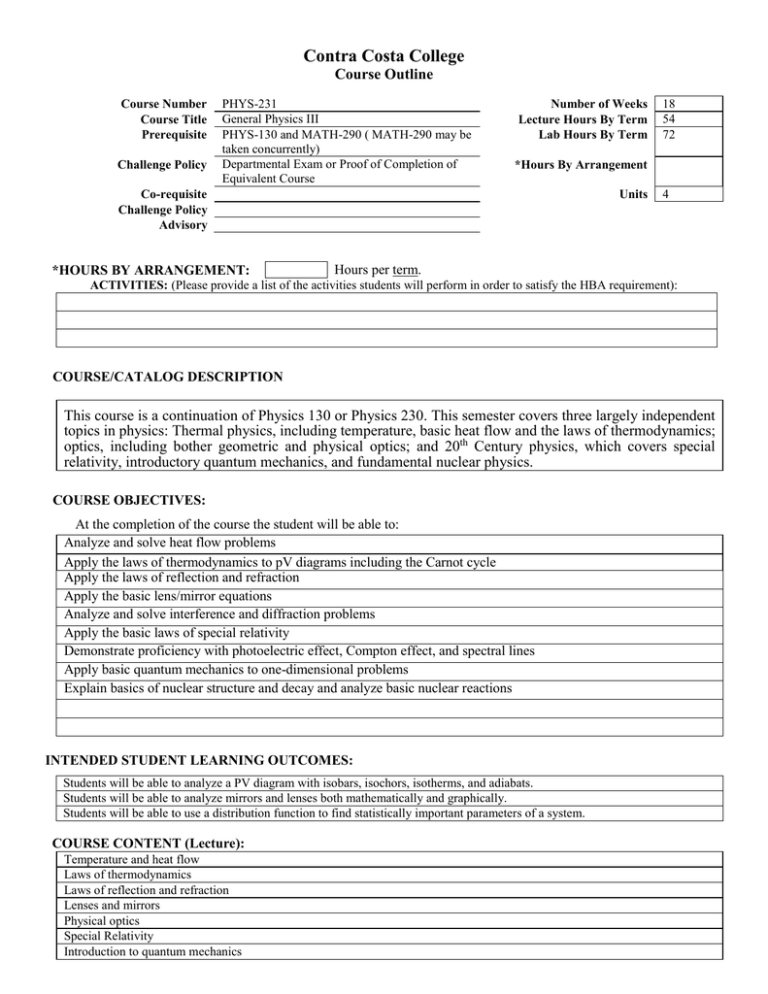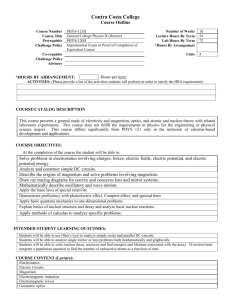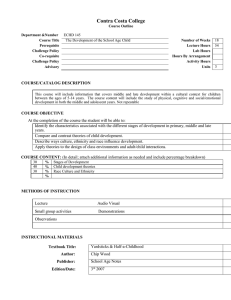
Contra Costa College
Course Outline
Course Number
Course Title
Prerequisite
Challenge Policy
PHYS-231
General Physics III
PHYS-130 and MATH-290 ( MATH-290 may be
taken concurrently)
Departmental Exam or Proof of Completion of
Equivalent Course
Number of Weeks
Lecture Hours By Term
Lab Hours By Term
*Hours By Arrangement
Co-requisite
Challenge Policy
Advisory
*HOURS BY ARRANGEMENT:
18
54
72
Units
4
Hours per term.
ACTIVITIES: (Please provide a list of the activities students will perform in order to satisfy the HBA requirement):
COURSE/CATALOG DESCRIPTION
This course is a continuation of Physics 130 or Physics 230. This semester covers three largely independent
topics in physics: Thermal physics, including temperature, basic heat flow and the laws of thermodynamics;
optics, including bother geometric and physical optics; and 20th Century physics, which covers special
relativity, introductory quantum mechanics, and fundamental nuclear physics.
COURSE OBJECTIVES:
At the completion of the course the student will be able to:
Analyze and solve heat flow problems
Apply the laws of thermodynamics to pV diagrams including the Carnot cycle
Apply the laws of reflection and refraction
Apply the basic lens/mirror equations
Analyze and solve interference and diffraction problems
Apply the basic laws of special relativity
Demonstrate proficiency with photoelectric effect, Compton effect, and spectral lines
Apply basic quantum mechanics to one-dimensional problems
Explain basics of nuclear structure and decay and analyze basic nuclear reactions
INTENDED STUDENT LEARNING OUTCOMES:
Students will be able to analyze a PV diagram with isobars, isochors, isotherms, and adiabats.
Students will be able to analyze mirrors and lenses both mathematically and graphically.
Students will be able to use a distribution function to find statistically important parameters of a system.
COURSE CONTENT (Lecture):
Temperature and heat flow
Laws of thermodynamics
Laws of reflection and refraction
Lenses and mirrors
Physical optics
Special Relativity
Introduction to quantum mechanics
Wave functions
Fundamental nuclear physics
COURSE CONTENT (Lab):
Calorimetry
Thermal expansion
Boyle’s Law
Heat engine
Lenses and mirrors
Optics observations and experiments
Snell’s Law
Spectroscopy
Photoelectric effect
Indirect measurements
Compton scatter/gamma spectrum analysis
End of program student project presentations
METHODS OF INSTRUCTION:
Lecture with demonstrations
Classroom discussions and activities
Problem solving
Laboratory experiments to explore the concepts discussed in class
Computer applications, including spreadsheets
INSTRUCTIONAL MATERIALS:
NOTE: To be UC/CSU transferable, the text must be dated within the last 7 years OR a statement of justification for a text beyond the
last 7 years must be included.
Textbook Title:
Author:
Publisher:
Edition/Date:
Justification Statement:
Textbook Reading Level:
Lab Manual Title
Author:
Publisher:
Edition/Date:
Physics for Scientists and Engineers: A Strategic Approach
Randall D. Knight
Pearson Addison-Wesley
3rd Edition / Copyright 2013
(For textbook beyond 7 years)
Contra Costa College Physics 231 Lab Manual
Celesia, J.; Wieber, D.; Wong, M.; et al
Contra Costa College Bookstore
Spring 2015
OUTSIDE OF CLASS WEEKLY ASSIGNMENTS:
Title 5, section 55002.5 establishes that a range of 48 -54hours of lecture, study, or lab work is required for one unit of credit.
For each hour of lecture, students should be required to spend an additional two hours of study outside of class to earn one
unit of credit.
Title 5, section 55002(a) 2F establishes that coursework calls for critical thinking and the understanding and application of concepts
determined by the curriculum committee to be at college level.
For degree applicable courses: List one example of critical thinking homework
Outside of Class Weekly Assignments
Hours per week
Weekly Reading Assignments (Include detailed assignment below, if applicable)
2
Chapter 19, Heat Engines and Refrigerators, pages 526 - 548
Weekly Writing Assignments (Include detailed assignment below, if applicable)
Weekly Math Problems (Include detailed assignment below, if applicable)
4
Problems and Conceptual Exercises 4, 8, 9, 16, 19, 22, 26, 27, 42, and 46
Critical thinking homework example:
Two events in reference frame S occur 10.0 microseconds apart at the same point in space. The distance between the
two events is 2400 m in reference frame S’. What is the time interval between the events in reference frame S’?
Lab or Software Application Assignments (Include detailed assignment below, if applicable)
Other Performance Assignments (Include detailed assignment below, if applicable)
STUDENT EVALUATION: (Show percentage breakdown for evaluation instruments)
Title 5, section 55002 (a) 2A establishes that the grade is based on demonstrated proficiency in subject matter and the ability to
demonstrate that proficiency.
For degree applicable courses: Course requires essay writing, or, in courses where the curriculum committee deems them
to be appropriate, by problem solving exercises, or skills demonstrations by students.
%
Essay
65
15
20
%
Computation or Non-computational Problem Solving Skills
%
Skills Demonstration
%
Objective Examinations
%
%
%
Other (describe)
Lab assignments
Homework
GRADING POLICY: (Choose LG, P/NP, or SC)
Pass / No Pass
X Letter Grade
90% - 100% = A
80% - 89% = B
70% - 79% = C
60% - 69% = D
Below 60% = F
70% and above = Pass
Below 70% = No Pass
Student Choice
90% - 100% = A
80% - 89% = B
70% - 79% = C
60% - 69% = D
Below 60% = F
Percentages vary from instructor
to instructor
or
70% and above = Pass
Below 70% = No Pass
Prepared by: Jon Celesia and Mark Wong
Date: Spring 2015
Revised form 09/14






